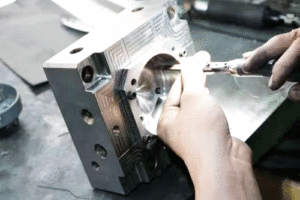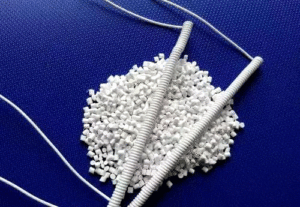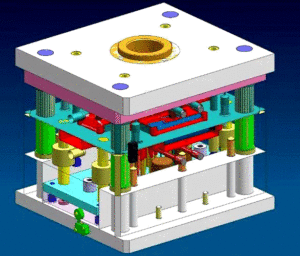
Polishing Treatment for Plastic Molds
Polishing Treatment for Plastic Molds With the widespread application of plastic products, such as daily-use items and beverage packaging containers, there is often a requirement
The decisive factors for the quality of the hydraulic system of injection molding machine:
The pollution of the system directly affects the reliability of the hydraulic system and the lifespan of components.
According to the statistics, about 70% of hydraulic system failures at home and abroad are caused by pollution. The main hazards of oil pollution to the system are as follows:
Various contaminants in the oil cause various forms of wear on the components. And solid particles enter the clearance of the moving pair, causing cutting wear or fatigue wear on the surface of the parts. The impact of solid particles in the high-speed liquid flow on the surface of the component causes erosion and wear. The water in the oil and the oxidative deterioration products of the oil have a corrosive effect on the components. In addition, the air in the oil of the system causes cavitation. Then, it leads to erosion and destruction of the component surface.
Solid particles block the gap and orifice of the hydraulic valve, causing the spool to block and jam, which affects the performance and even leads to serious accidents.
The water and air in the oil are the main conditions for the oxidation of the oil, and the metal particles in the oil play an important role in catalyzing the oxidation of the oil. In addition, the water and suspended bubbles in the oil significantly reduce the strength of the oil film between the motion pair and reduce the lubricating performance.
Contaminants are the substances in the oil in hydraulic system. And they are harmful to the system. They exist in various forms in the oil. According to their physical forms, they can be classified into solid pollutants, liquid pollutants, and gaseous pollutants.
(1) Solid pollutants can be divided into hard pollutants and soft pollutants. The former include diamond, cutting, silica sand, dust, wear metals and metal oxides. The latter include additives, water condensate, oil decomposition products and polymers, cotton filaments and fibers brought in during maintenance.
(2) Liquid contaminants generally are grooving oil, water, paint and chlorine and their halides that do not conform to the requirements of the system. It is usually difficult to remove them, so you can choose the kind of hydraulic oil that meets the system standards to avoid some unnecessary failures.
(3) Gaseous pollutants is mainly the air mixed into the system.
These particles are often so small that they cannot settle down and they are suspended in the oil. They are eventually squeezed into the gaps of various valves. In a reliable injection molding machine hydraulic system, these gaps are extremely important for the implement of limited control, importance and accuracy.
The sources of pollutants in the system oil mainly include the following aspects:
(1) Externally invaded pollutants
Externally invaded pollutants are mainly gravel or dust in the atmosphere. They generally invade the system through the air holes of the oil tank, the shaft seal of the oil cylinder, the pump and the motor and other shafts. Operational environment is the main affecting fators.
(2) Internal pollutants
They are the pollutants left over by components during processing, assembly, commissioning, packaging, storage, transportation and installation. Of course, these processes are unavoidable, but the pollutants can be minimized. Some special components needs assembling and debugging in a clean room or clean bench.
(3) Pollutants generated by the hydraulic system of the injection molding machine
The wear of the components generates some particles during the operation of system. Sand particles fall off the castings. Metal particles fall off the pumps, valves and joints. Rust exfoliation in the pipeline. Particles and gums produced by the oxidation and decomposition of the oil. The more serious one is the large amount of impurities formed in system pipelines because the pipelines have not been washed before they are officially put into operation.
A system is generally swilled before it is officially put into operation. The purpose of that is to get rid of contaminants, metal shavings, fiber compounds, iron cores, etc., which remain in the system. During the first two hours of operation, even though the system is not completely damaged, it will cause a series of failures. Therefore, the system oil circuit should be cleaned according to the following steps:
And then, install a flushing plate on the collector to replace precision valves, such as electro-hydraulic servo valves.
If you use an electro-hydraulic servo valve in the system, the flushing plate of servo valve must ensure the oil can flow from the oil supply line to the collector and return directly to the tank, so that the oil can be circulated repeatedly to flush the system and the oil filter can filter out solid particles.
Check the oil filter every 1 to 2 hours during the flushing process to prevent the oil filter from being blocked by contaminants. Do not open the bypass at this time.
Change the oil filter immediately as soon as oil filter starts to clog up.
The structure and the contamination degree of the system determine the flushing cycle. If the sample of the filter medium has no or few foreign pollutants, install a new oil filter, then remove the flushing plate and install the valve to work!
Establish a regular maintenance system for the system. The recommended maintenance systems for the injection molding machine hydraulic system are as follows:
Regularly flush the inlet oil filter of the oil pump.
And then, repair the leak in the system.

Polishing Treatment for Plastic Molds With the widespread application of plastic products, such as daily-use items and beverage packaging containers, there is often a requirement

Injection Molding Techniques for TPE and TPR Injection Molding Techniques for TPE and TPR 1. Dry the TPE and TPR material before injection molding It

Winter Maintenance Measures for Injection Molding Machines As winter approaches and temperatures gradually drop, a cold chill envelops the earth. While ensuring personal warmth, it

Assessment Regulations for Mold Trial Exceeding 3 Times Assessment Regulations for Mold Trial 1. Purpose The purpose of this regulation is to standardize the work of